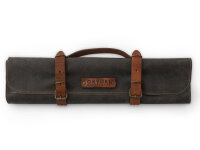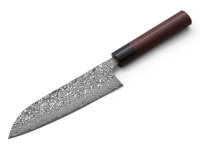"Knife Set Damascus Knife Nami Santoku II"
Hiroshi Kato - a true master of Japanese knives
He is the second master blacksmith and knife maker in the family. He learned the fine art of forging knives of exceptionally high quality from his father, Kintaro Kato. Traditionally, this was the usual way in which the skills and \"secrets\" of the masters were passed on. Traditions played an important role for Hiroschi Kato, but he is also a person of change. As a co-initiator, together with other master blacksmiths, he founded the knife village Takefu with the aim of preserving the old knowledge, exchanging experiences and passing them on to young blacksmiths. One of the boys was Yoshimi Kato, son and successor of Hiroshi, who is now also one of the masters. Hirosho Kato, today, after almost 60 years of work, mostly rests the blacksmith's hammer and is mainly responsible for quality, further development and training. in 2008, Hiroshi Kato became the second knifemaker to receive the Certificate of Traditional Craftsmen, a high distinction for excellence in craftsmanship.
Yoshimi Kuroshiage Nami Knife Series
Material: Shirogami 2, the ultimate knife steel. The white paper steel Shirogami is very similar to the famous Aogami (blue paper steel) but even more uncompromisingly focused on hardness and sharpness. Completely devoid of chrome and tungsten, Shirogami is a high performance unalloyed steel designed for knives that value sharpness and a fine cut above all else. The extraordinary sharpening potential and the possible fine cuts are the domain of kitchen knives made of shirogami. It should be noted that these knives do require some attention, the steel is not stain resistant and, being a pure carbon steel, rusts relatively easily. After use, these knives should always be hand washed and dried, even though the Kuroshiage Nami provides some protection in the upper area. More important than protection from rust, however, is the fact that Kuroshiage provides some comfort to the user. Slices of cucumber and onion stick noticeably less, making the nice job much easier to do. Wafer-thin fillets of fish or meat, fine slices of cucumber, tomato or onion have little chance to stick to the blade. Visually, it is a real treat for enthusiasts, Japanese knives with this finish are in great demand. Handle: The knife handles of Kuroshiage Nami series are round in design, very comfortable and convenient even during prolonged handling. The Rosewood - a Rosewood - is characterized by very high durability and resistance, the dark grain looks extremely noble.
How to use
Japanese chef's knives are made of extremely hard steels and are forged and ground thinner than their European counterparts. Some of these knives have very finely ground cutting layers, making them more delicate and suitable only for soft cut foods. Please refer to the product details for information in this regard. In particular, knives with a very thin cutting edge and hollow grind are prone to chipping on the blade. These are excellent for fine cuts of soft cut material, but should be used with appropriate care. Sharpening on a whetstone usually produces an angled grind, which makes the edge more stable over time.
Breakouts on the cutting edge can also occur due to leverage forces as well as frozen cuttings, which significantly reduce the temperature of the steel. Leverage forces often occur when cutting material with bones, for example. Chipping on the cutting edge may need to be ground out by a professional.
The knife should always be guided straight with pulling or pushing cut, without much pressure. To maintain sharpness, avoid cutting on stone, glass or other hard surfaces. Never use \"sharpening steel\" for resharpening. Water sharpening stones are recommended (grit: 400-1200 for preliminary sharpening, 3000 for fine sharpening, 6000 or more to strip the blade) and a honing leather if necessary.
Please keep the knife away from children. These knives are extremely sharp, please be careful.
All products are unique, slight deviations from the exemplary picture are therefore possible.
Care instructions
When using knives made of delicate types of steel, such as Aogami, Shirogami or V-Toku, please clean them occasionally with a cloth and water even during prolonged use. However, acidic foods can still cause discoloration on these classic carbon steels. After use, please wash by hand with hot water and use a neutral dishwashing detergent if necessary. Please do not put the knife in the dishwasher under any circumstances. After cleaning, dry thoroughly, oil if necessary, and store in a well-ventilated area. Residual moisture can cause rust in non-stainless steels. See our posts on the ORYOKI Japan blog for product care.
Clean the knife by hand and do not use a dishwasher. Dry it thoroughly afterwards.























